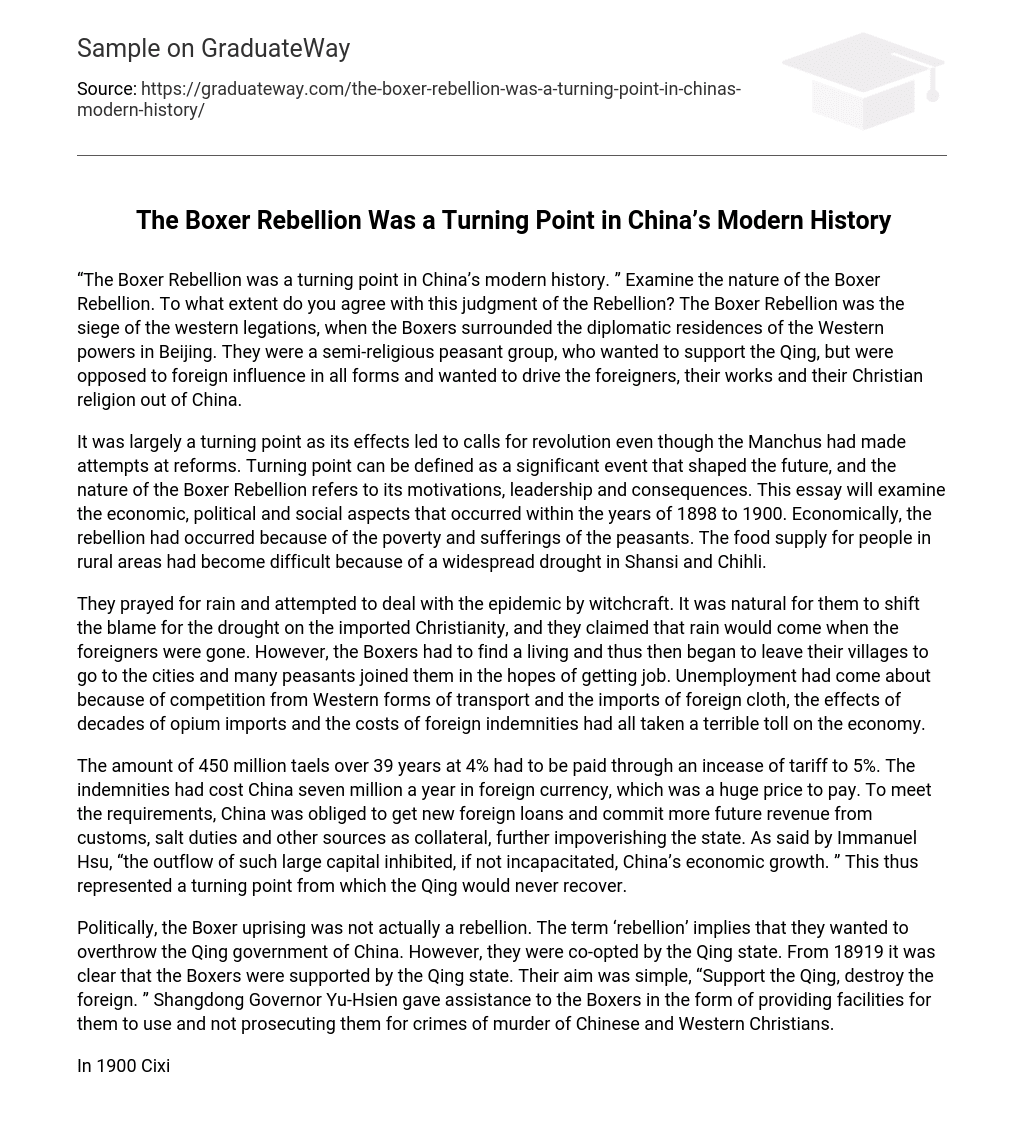“The Boxer Rebellion was a turning point in China’s modern history. ” Examine the nature of the Boxer Rebellion. To what extent do you agree with this judgment of the Rebellion? The Boxer Rebellion was the siege of the western legations, when the Boxers surrounded the diplomatic residences of the Western powers in Beijing. They were a semi-religious peasant group, who wanted to support the Qing, but were opposed to foreign influence in all forms and wanted to drive the foreigners, their works and their Christian religion out of China.
It was largely a turning point as its effects led to calls for revolution even though the Manchus had made attempts at reforms. Turning point can be defined as a significant event that shaped the future, and the nature of the Boxer Rebellion refers to its motivations, leadership and consequences. This essay will examine the economic, political and social aspects that occurred within the years of 1898 to 1900. Economically, the rebellion had occurred because of the poverty and sufferings of the peasants. The food supply for people in rural areas had become difficult because of a widespread drought in Shansi and Chihli.
They prayed for rain and attempted to deal with the epidemic by witchcraft. It was natural for them to shift the blame for the drought on the imported Christianity, and they claimed that rain would come when the foreigners were gone. However, the Boxers had to find a living and thus then began to leave their villages to go to the cities and many peasants joined them in the hopes of getting job. Unemployment had come about because of competition from Western forms of transport and the imports of foreign cloth, the effects of decades of opium imports and the costs of foreign indemnities had all taken a terrible toll on the economy.
The amount of 450 million taels over 39 years at 4% had to be paid through an incease of tariff to 5%. The indemnities had cost China seven million a year in foreign currency, which was a huge price to pay. To meet the requirements, China was obliged to get new foreign loans and commit more future revenue from customs, salt duties and other sources as collateral, further impoverishing the state. As said by Immanuel Hsu, “the outflow of such large capital inhibited, if not incapacitated, China’s economic growth. ” This thus represented a turning point from which the Qing would never recover.
Politically, the Boxer uprising was not actually a rebellion. The term ‘rebellion’ implies that they wanted to overthrow the Qing government of China. However, they were co-opted by the Qing state. From 18919 it was clear that the Boxers were supported by the Qing state. Their aim was simple, “Support the Qing, destroy the foreign. ” Shangdong Governor Yu-Hsien gave assistance to the Boxers in the form of providing facilities for them to use and not prosecuting them for crimes of murder of Chinese and Western Christians.
In 1900 Cixi accepted the Boxers at Court and incorporated them into the Qing armies. On June 21, she formally declared war on the foreign powers. As she said, “China is weak. The only thing we can depend upon is the hearts of the people. If we lose them, how can we maintain our country? ” She believed that the spirit displayed by the Boxers was needed to cleanse China of the scourge of imperialism. The decision made by Cixi and her court showed that the Qing dynasty was incapable of ruling China.
Although they began to implement reforms in 1898, many Chinese saw no further hope in the Qing state and thus turned to revolution. The Boxer Rebellion accelerated demands for further reform and revolution. Sun Yat-sen’s advocacy of a forceful overthrow of the Qing government received increasing sympathy and support, and this changed his image from that of a disloyal rebel to that of a patriotic revolutionary. The overthrow of the Qing in 1911 is therefore partly due to the Boxer uprising, thus showing that it was a major turning point.
Socially, the boxers hailed from impoverished provinces in Northern China. They were mostly peasants who hated foreigners for their interference in the traditional life of China. The Gospels were destroying the religious belief of the peasants and the guns and warships were aiming at China’s dignity. They believed that their sufferings were due to the presence of the foreigners and the Western practices in China. They attributed the flooding of the Yellow river, famines and unemployment to the angering of the gods ho then punished them for allowing modern infrastructure to disturb the land. In faith, they found strength; but when faith and superstition were blended, they imagined that they could also find the means to wipe out the foreigners. As a result, the movement was a heretical one. The protocol dealt a deathblow to the imperial examinations system. Although the exams were only suspended in 45 cities for five years, this foreshadowed the eventual abolition of the exams by the Qing state in 1905. This represented the greatest cultural change in China in two thousand years.
It was a turning point for education and government administration, as a modernized Western syllabus would come to be of greater value and prestige in Chinese society. In conclusion, it can be seen that the Boxer Rebellion was a peasant-led movement against the forces of modernization. It involved economic, political and social aspects of China. The effects of the movement showed that it was a key turning point in discrediting the Qing regime, which was clearly unable to re-establish China in all of its internal and external problems.





